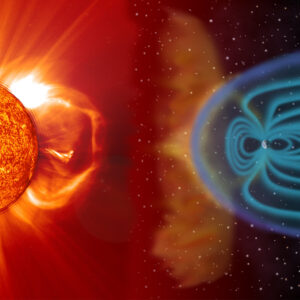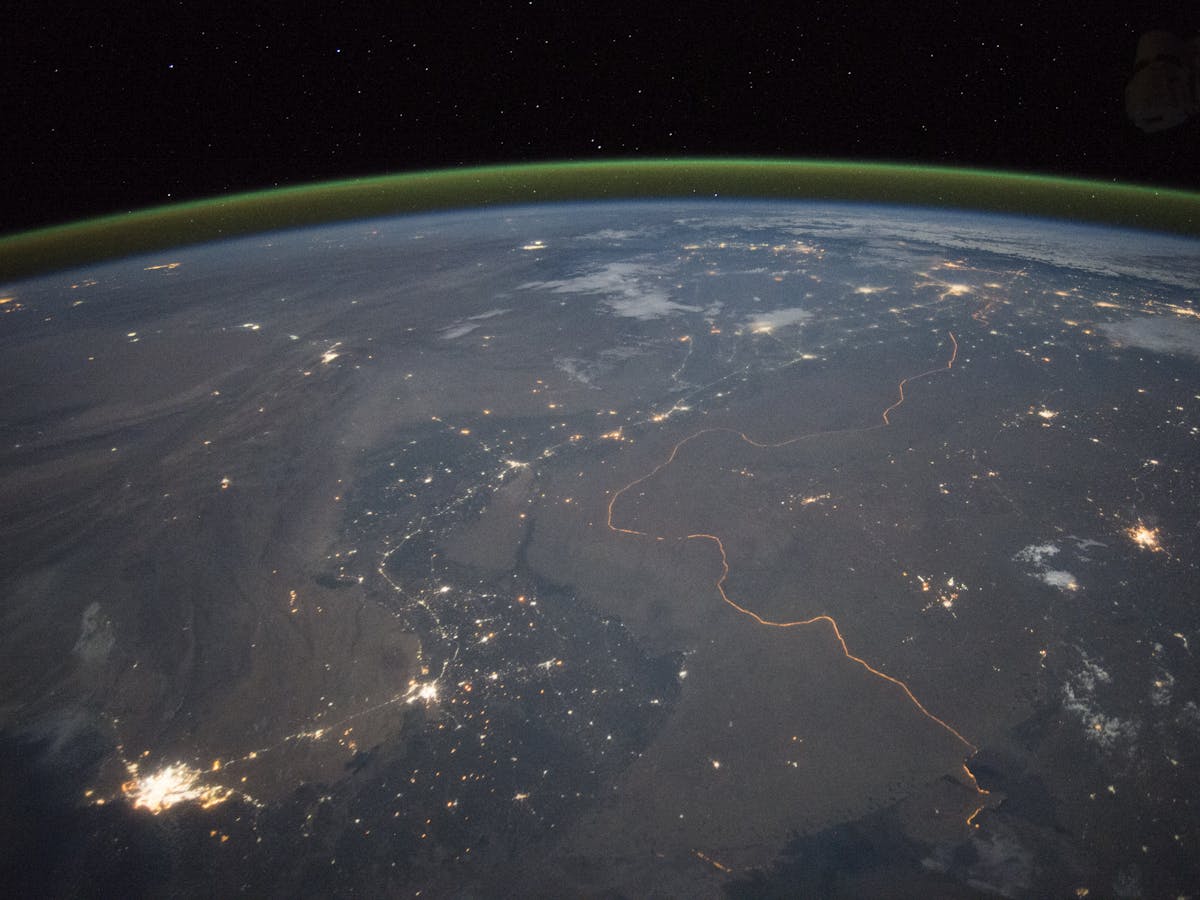
The Magnetometer Network of Ireland
Space Weather Research
What is Space Weather?
Scientists have long been predicting if there will be rain or shine tomorrow, but we can also predict events happening much higher up from the ground, in Earth’s upper atmosphere. These events seem to have little effect in our daily lives, as the Sun constantly spits out material that comes into contact with the magnetic field around Earth which protects us from harmful radiation. This material can change the atmosphere and create technological problems, like interfering with radio communication on Earth, but also create beautiful visuals in our night skies like the Northern Lights and Southern Lights. Space weather covers a variety of phenomena that occur because of the Sun’s turbulent behaviour, and its predictions are becoming more important as we further advance technology.
The Magnetometer Network of Ireland (MagIE) is a network of Irish geomagnetic observatories, founded in 2012 by DIAS and TCD School of Physics, to complement Met Eireann’s existing Valentia observatory. The goal of the network is to improve our understanding of space weather in Ireland. The network currently consists of observatories in Armagh, Dunsink, and Valentia. The magnetometers at each site measure the magnetic field strength of the Earth, which helps identify the presence of geomagnetic storms.
Down below you can learn more about the Sun and the Earth, and different space weather events and why we predict them. We are also currently creating some educational resources for teachers and students, or just those who would like to learn a bit more – Stay tuned!
The Sun and Earth
The Sun is made up of different layers with the lowest layer of its atmosphere being the most active. It is constantly releasing energetic material into space which can protect our solar system but can also be of danger to us on Earth. A well known example of this is UV rays, which are mostly blocked by our atmosphere, but by wearing sunscreen we can protect ourselves from the UV rays that make it through.
Our solar scientists look at pictures of the Sun and see what is happening at any given moment. In the image to the right, you can see dark spots which we refer to as sunspots. These sunspots show us an area where the magnetic field is so strong that the heat cannot travel to the surface. We can count how many sunspots there are to know how active the sun is, and what we see is that there is a pattern where the number of sunspots slowly goes from solar maximum (most amount spots) to solar minimum (least amount spots) and back to maximum again, and this cycle takes roughly 11 years.
Click on the image to see what the Sun looks like today!
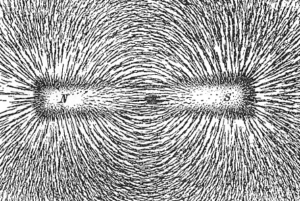
As mentioned earlier, the Earth has a magnetic field because the Earth acts as a giant magnet. All magnets have a north and south pole, and lines that run between them, which are not visible to us. You can however get a good look at these lines using a bar magnet and magnetic fillings similar to the image to the left. The North pole that we are familiar with is in fact a few hundred kilometres away from our magnetic north pole, which is where a compass points to. Most compass apps will allow you to swap between magnetic north and true north, and here in Dunsink the difference between them is roughly 2°. The Earth’s magnetic field, magnetosphere, is actually shaped a bit differently than a perfect sphere because the material from the Sun pushes out of shape.
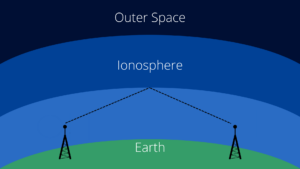
Looking closer at the different layers of Earth’s atmosphere, the Ionosphere is the outermost layer where the atmosphere meets space, and this section is important because it reflects and changes radio waves used for communication and navigation. We can bounce radio waves off the ionosphere and this allows the radio wave to travel further. However this layer is being hit by the material coming from the Sun which can change the radio wave or where it is going.
From Solar Storm to Geomagnetic Storm
The Sun is constantly sending out a relatively small amount of energetic material, a constant solar wind, and similar to weather on Earth things are not always calm. There can be eruptions of energy which are called solar flares. These solar flares are flashes of light and radiation that travel at the speed of light and reach Earth in 8 minutes.
Coronal mass ejections (CMEs) are giant clouds of charged gas that travel much slower and can take from 15 hours to a few days to reach Earth. You can think of flares like lightning and CMEs as a more dangerous thunder that follows. This delay is an advantage as solar flares can act as a warning and gives engineers and scientists time to prepare for the incoming CMEs.
A geomagnetic storm is what we call a solar storm once it hits Earth. This is because the material released from the Sun has an effect on our magnetic field. Electricity and magnetism are very tightly linked so that when you have a changing magnetic field it creates a current and the same the other way around. This important fact is the basis of how generators work like the one on the left. This is useful for us to induce or create electric currents, but when there are changing magnetic fields beyond our control it can make work more difficult for engineers and scientists.
As the solar storm hits Earth, the CME contains electrically charged particles which change our magnetic field, which then creates an electric field which messes with any electrical device here on Earth. This can cause power surges that overwhelm our electricity grid and lead to blackouts. In 1989 a power surge occurred in Quebec, Canada and there was a power outage for 9 hours.
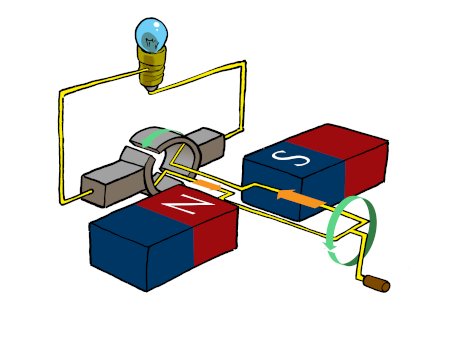
What types of space weather are there?
The Good vs The Bad
(Click each image to find out)
Why is predicting space weather important?
Scientists are able to make a forecast for space weather, this allows us to predict and monitor space weather events and put in any precautionary measures. The cost of preventing space weather disasters is much lower than that of any other natural disaster. A few hundred years ago space weather events would pose no harmful effects to human life, but in a time where we rely heavily on electricity and technology we need to be aware of these phenomena. However, there are many scientists dedicated to this field making predictions and keeping a watchful eye, so no need to worry. As well as this one of the important reasons we do science is to find out more, try to answer questions we have, and sometimes that leaves us with even more questions. You can read more about the different levels of events, what they impact, and how often per solar cycle they occur – Measure the impact.
You can look at our live data graphs to see how turbulent space weather is at the moment. The colours in the table below show the severity of the storm.
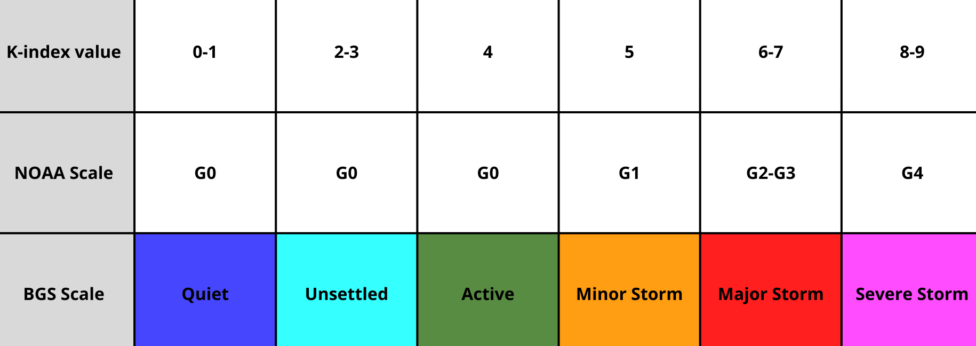
FAQ
The main piece of equipment we use is a magnetometer and this is where we get our name. To find out more visit our instrumentation page.
If you would like to read more on the topic here are some website we recommend:
An important part of MagIE is our schools network where we are connecting with schools across Ireland giving students the tools to contribute to important scientific research. You can find out more here. We are a part of Dunsink Observatory which is open to members of the public for events and an escape room which you can book tickets for here .
In collaboration with the DCU STEM Teacher Internship Programme and UCD School of Education, we are developing teacher resources for the Earth and Space strand of the Junior Cycle Science Curriculum Specification as part of our MagIE Schools Network project. Find what we have done so far here and stay tuned for more!
